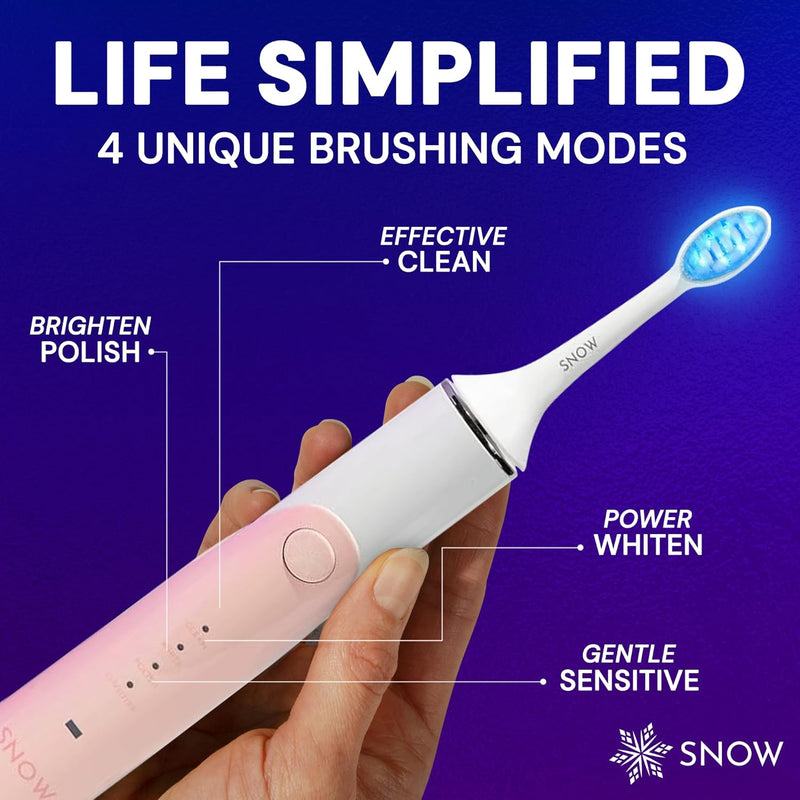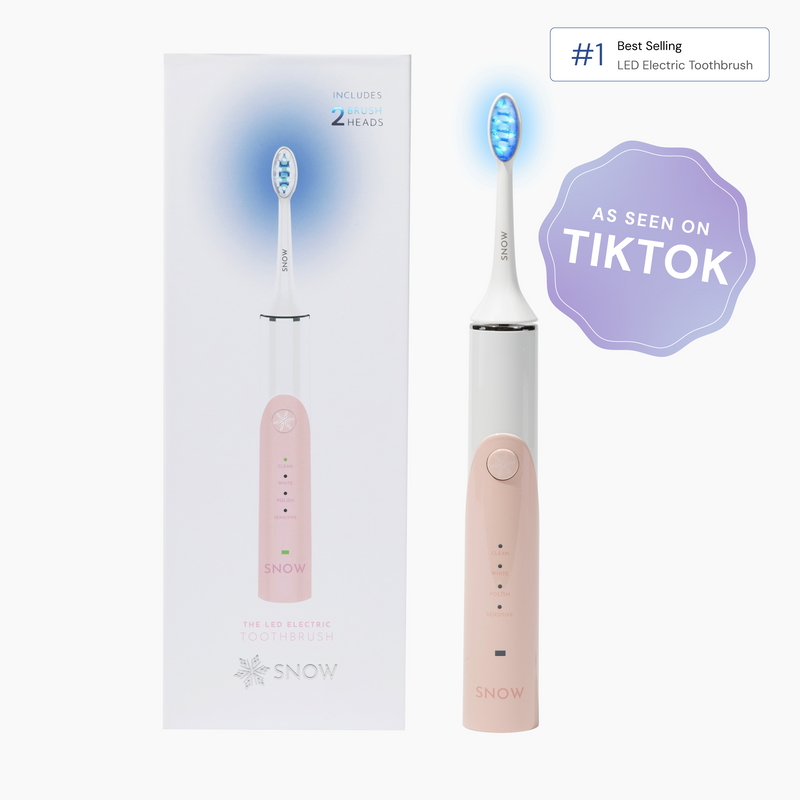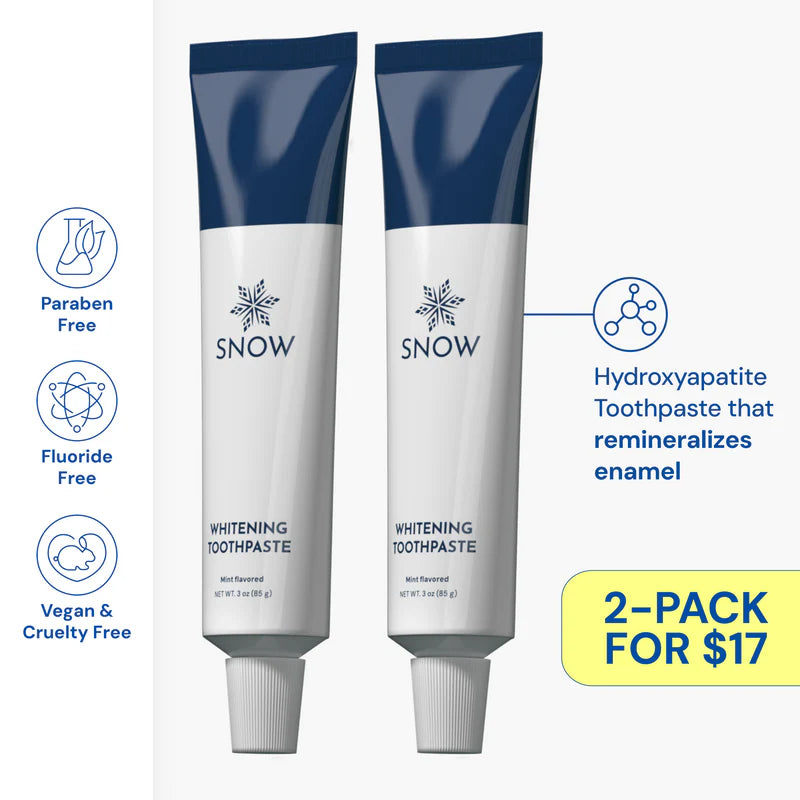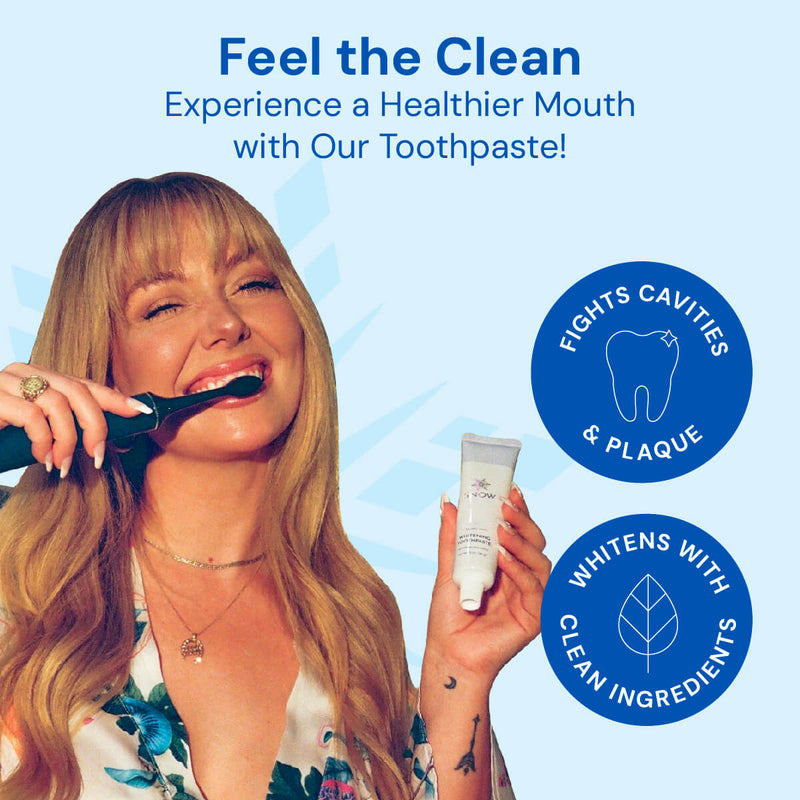Why do my teeth look more yellow after whitening strips? This common concern arises because whitening strips can dehydrate your teeth, temporarily affecting their ability to reflect light and making them appear more yellow.
This effect is usually short-lived, and normal coloration often returns shortly. In this article, we'll delve into the reasons behind this phenomenon, preventive measures, and effective solutions for achieving and maintaining a whiter smile.
We'll also answer frequently asked questions to demystify the teeth whitening process and help you attain the bright smile you desire with confidence.
What this article covers:- Why Do Your Teeth Still Look Yellow After Whitening Strips?
- How Long Does It Take to Whiten Yellow Teeth with Strips?
- How to Prevent Yellow Teeth After Whitening Strips
- Yellow Teeth After Whitening FAQs
Why Do Your Teeth Still Look Yellow After Whitening Strips?
At SNOW, we understand that achieving a bright and appealing smile is important to our customers. However, sometimes after using whitening strips, you might notice that your teeth still look yellow. This can be confusing and frustrating, but there are several reasons why this might occur. The American Dental Association (ADA) provides valuable insights into the nature of tooth discoloration and the effects of whitening treatments.
Extrinsic Vs. Intrinsic Stains
Tooth discoloration can be classified into two types: extrinsic and intrinsic stains. Extrinsic stains are surface stains caused by environmental factors or individual behaviors, such as tobacco use or consumption of pigmented foods and beverages. These stains can often be effectively reduced with whitening toothpaste or professional cleaning. However, whitening strips might not fully address deeper, intrinsic stains, which occur inside the tooth and can be due to systemic causes or local factors. Intrinsic stains can be more challenging to remove and might require professional dental procedures for effective treatment.
Whitening Agents And Their Effects
The bleaching action in whitening treatments is primarily due to carbamide peroxide or hydrogen peroxide. These agents work by creating a chemical reaction that changes the color of the tooth. However, the effectiveness of these agents can vary based on the type of intrinsic stain being treated. For example, brown stains due to fluorosis or tetracycline may respond better to bleaching than white stains associated with fluorosis or orthodontic treatment.

Patient Considerations And Preferences
It's important to consider individual factors when using whitening treatments. Patients with tooth-colored restorations should be aware that only natural teeth will be affected by the bleaching agent, potentially leading to color differences between natural teeth and restorations.
Additionally, the ADA notes that some research suggests bleaching protocols may alter the surface roughness of enamel, which could affect the bond strength between enamel and restorative materials.
At SNOW, we recommend consulting with a dental professional before starting any whitening treatment, especially if you have sensitive teeth, dental restorations, or very dark stains. Understanding the nature of your tooth discoloration and the best treatment options for your specific needs is crucial for achieving the best results.
How Long Does It Take to Whiten Yellow Teeth with Strips?
The duration required to whiten yellow teeth using whitening strips can vary, but generally, you can expect to see initial results within a few days and more significant results after a few weeks of consistent use. According to WebMD, a trusted source in health information, whitening strips are typically applied directly to the teeth for about 30 minutes to an hour, depending on the product's instructions. Initial results are often visible in a few days, and the final outcome usually lasts about four months.
At SNOW, we align with these general guidelines in our whitening strip design. Our advanced formula is crafted to ensure that users start noticing their teeth becoming brighter within just a few days of consistent application.
For the best results, we recommend using our Magic Teeth Whitening Strips as directed for the full course, which is typically around 10 to 14 days. This approach ensures that the whitening process is thorough and effective, leading to a brighter and more consistent smile.
It's important to follow the product instructions carefully to avoid any potential issues like tooth sensitivity or gum irritation. With SNOW whitening strips, achieving a brighter smile is both safe and convenient, providing you with professional-level results from the comfort of your home.
How to Prevent Yellow Teeth After Whitening Strips
At SNOW, we are dedicated to ensuring that our whitening strips not only effectively whiten your teeth but also maintain their brightness. It's important to understand that yellowing is not a byproduct of using our whitening strips.
Instead, they're specifically designed to whiten teeth, not yellow them. However, certain factors can influence the color of your teeth after whitening. Here are some tips to prevent yellowing and maintain that dazzling smile:
Stay Hydrated
Drinking plenty of water is crucial for overall oral health and helps in rehydrating your teeth. Water aids in washing away food particles and residue that can lead to staining. It also keeps your mouth hydrated, which is important for preventing decay and maintaining cleanliness.
Avoid Stain-Causing Foods and Drinks
Beverages like coffee, tea, and red wine are known for causing stains due to their high tannin content. These tannins attach to the enamel on your teeth and can form yellowish stains over time. To minimize their impact, consider using a straw when drinking these beverages and rinse your mouth with water afterward.
Follow Instructions Carefully
It's essential to follow the product instructions carefully when using whitening strips. Overuse or incorrect application can lead to enamel damage, making teeth more prone to yellowing. Our SNOW whitening strips are designed for safe and effective use when applied as directed.
Regular Dental Hygiene
Maintaining good oral hygiene is key to preserving the whiteness of your teeth. Brushing twice a day and flossing regularly helps remove plaque and prevent build-up that can cause yellowing. Using a soft-bristled toothbrush and fluoride toothpaste is ideal for removing plaque gently without damaging the enamel.
Quit Smoking
Smoking is a major contributor to teeth discoloration. The tar and nicotine in tobacco products can cause persistent yellowing and are difficult to remove with regular brushing. Quitting smoking can help prevent further discoloration and improve overall oral health.
Yellow Teeth After Whitening FAQs
Can some teeth not be whitened?
Yes, certain types of discoloration, such as those caused by medications or tooth injury, may not respond well to traditional whitening methods. In such cases, consulting with a dental professional is advisable.
Can badly yellow teeth be whitened?
Badly yellow teeth can often be significantly whitened with at-home products like SNOW's whitening strips. However, the degree of whitening may vary based on the cause and severity of the yellowing.
Is it too late to fix yellow teeth?
It's never too late to improve the appearance of yellow teeth. With the right products and practices, you can always work towards a brighter smile.
Is teeth yellowing permanent?
Teeth yellowing is not always permanent. Many causes of discoloration can be addressed with proper dental care and whitening treatments.
Why do teeth take so long to whiten?
Teeth whitening is a gradual process. The duration depends on factors like the type of staining, the whitening method used, and individual tooth response. Patience is essential for safe and effective results.
Conclusion
Discovering that your teeth look more yellow after using whitening strips can be perplexing, but it's often a temporary effect due to factors like enamel dehydration and dietary habits.
At SNOW, we're committed to providing effective solutions for at-home teeth whitening.
Our products are designed to combat yellowing and enhance your smile. Remember, staying hydrated, avoiding stain-causing foods, following product instructions, and maintaining regular dental hygiene are key to preserving your dazzling smile.
For a brighter, more confident smile, explore our range of teeth whitening products. Let SNOW guide you towards the radiant smile you deserve!
If you enjoyed this article, check out some of our related posts:
- Why Do My Teeth Never Get White
- Why Are My Canine Teeth Yellow
- How To Check If Your Teeth Are Yellow
- Why Are My Teeth Not Whitening
- Why Are Teeth White
- Why Are My Top Teeth Whiter Than My Bottom Teeth
- What Drinks Stain Your Teeth?
- Does White Wine Stain Teeth?
- Does Chicory Stain Teeth?
- Does Pomegranate Juice Stain Teeth?
- Does Diet Soda Stain Teeth?
- How to Fix Stained Teeth
- Hard Water Stains on Teeth
- Stained Teeth Causes
- Does Porcelain Teeth Stain?




































































